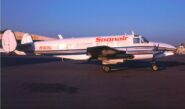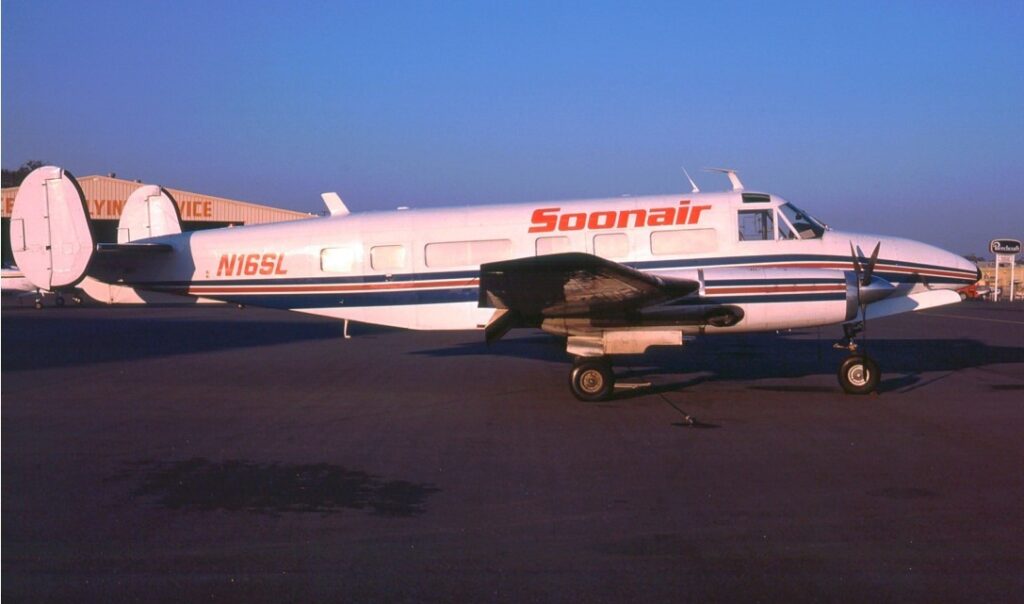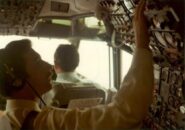Emery Air Freight,Federal Express,Metro I,Metro II,pilot,pilot career,Portland,Purolator Courier,Soonair Lines,Swearingen,Tulsa,Volpar
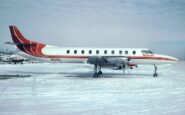
TURBOPROPS, ROUND TWO: Soonair Metroliner
By Ellis M. Chernoff
Following rounds of flying the three SoonAir Lines Volpar Turboliners on contract schedules for Purolator Courier, Federal Express, and Emery Air Freight, I was to transition to the Swearingen SA-226TC Metroliner. Soonair operated three of these aircraft as well, with one early production Metroliner I that was converted from a corporate Merlin IV, a second early Metro I, and a single Metro II that had
previously operated in Alaska. The outward distinguishing characteristic of the Metro I vs. Metro II was the passenger cabin windows. Early Metro Is had round windows, while later versions and the Metro IIs had conventional airline-shaped windows. The early Metro I also had an electric nose steering system controlled with a tiller to the left of the captain’s seat. Later production changed to a hydraulic system controlled through the rudder pedals. More on that later.
As was the case with my Volpar training, my transition training was limited, consisting of a single two-hour flight in mid-January 1980. These planes were equipped with excellent radios and flight instruments, but no flight directors or autopilots. In fact, the entire Metro was more of a scaled-down airliner than a scaled-up general aviation light aircraft. The systems and structures were certainly air transport
grade, including pressurization, wet wing fuel tanks, de-ice and anti-ice systems, and the flight controls. However, with a maximum gross weight of 12,500 pounds, it was certified under FAR Part 23 and did not require a type rating.
The engines were similar to those installed on the Volpar, but were the more powerful TPE-331-303 of 840 shaft horsepower. Unlike later versions of the -331 line, these were rated as above at sea level and standard temperature of 59 degrees F. To achieve the rated power, the engines had to be advanced right up to the turbine temperature limit of 923 degrees Celsius at and above standard conditions. If it
were colder, the power limit was reached at a torque limit value; I don’t recall the exact number but it was around 2,200.
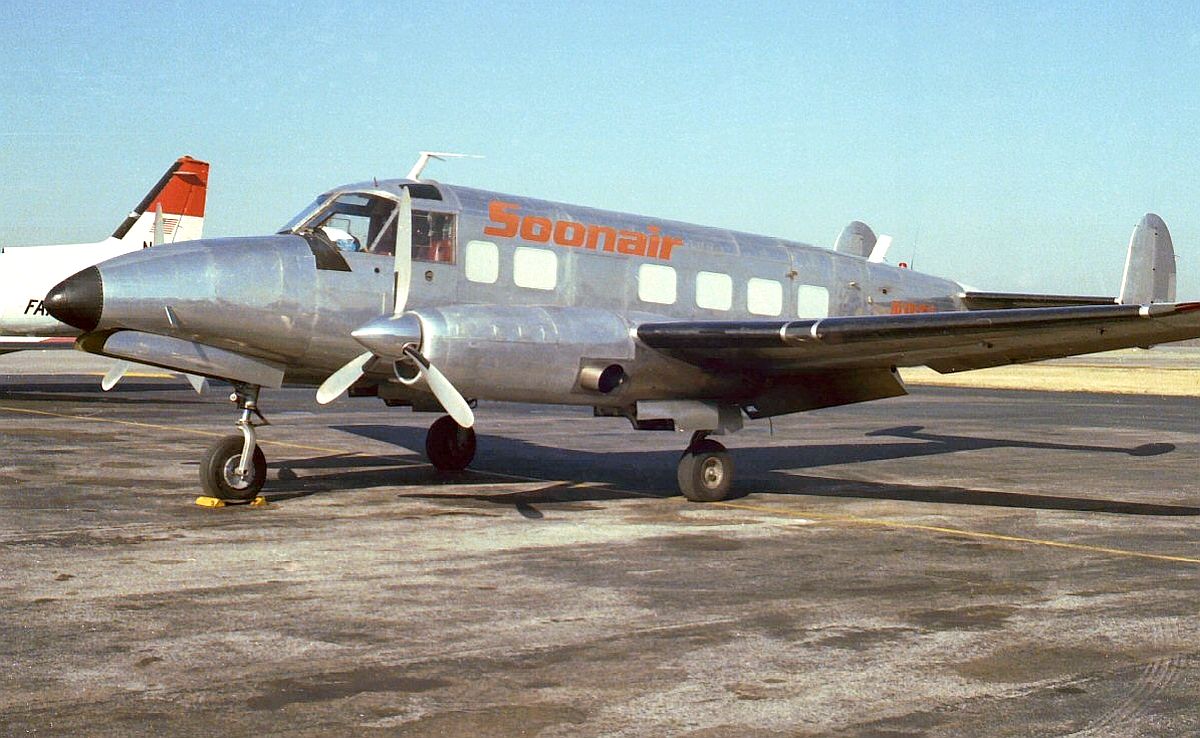
Conversion of a stretched variant of the Beech 18 began in December 1966, which would eventually lead to the 15-seat Volpar Turboliner 1. The aircraft was certificated on March 29, 1968.
The fuselage was stretched by 81 inches (2.07m), and TPE-331-101b engines were installed. Its maiden flight on was on April 12, 1967. N8SL originally operated for Allegheny Commuter as N342V.
Photo by Ellis M.Chernoff.
My short training flight was uneventful, with the exception that I noted something strange about the engines on the Metro II. With fuel flow and ITT temperatures matched on the two engines, the torque reading on one engine was much lower than the other, requiring me to adjust the rudder trip as the thrust/power was not matched. However, if I matched the torque indications, I could center the trim, but
the other parameters were uneven. I brought this to the attention of the chief pilot, who was conducting my training. He answered that this plane had been this way since they received it after it had been in an accident in Alaska. Since the offending engine only had seven hours at the time they got it, SoonAir chalked it up to an indication error. I didn’t see it that way.

In fact, an FAA inspector was aboard the following day for my checkride. Once we were established in cruise condition, he got into a heated discussion with the chief pilot while I just flew the plane and stayed out of the argument. Of course, aerodynamics don’t lie, and since the airplane was in trim when the torques matched, clearly there was something amiss with an engine and not just an indication. The FAA inspector terminated the ride, ordering us to land at the nearest airport and let him off. He called his wife to pick him up, and my chief pilot got back on board the aircraft and closed the door. “We will finish the checkride and I will sign you off,” was the answer to my question.
I finally got out on the line with the chief pilot flying a revenue trip. Approaching the first stop, the Tower reported the runways closed with snow removal in progress. My right-hand man was working the radio communications and insisted we could not wait a significant time for them to finish. So what was negotiated was that the equipment would clear the runway and I would land on the cleared portion, which was not in the center of the runway.
All of my Soonair Lines Metroliner flying would be on two routes for Purolator Courier with nightly hub operations at Port Columbus, Ohio (CMH). Operating this type of plane was great since it could carry plenty of fuel and cargo, and was pressurized and heated. The ice protection systems were certified for flight into known icing as well. The engines were reliable, but the only concern was getting them started. The Garrett is a single-shaft design that has an automatic start sequence. A great deal of electrical power is required to get the thing started, and trying to do that on internal battery power alone is dicey, especially in cold conditions. A ground power unit was essential.
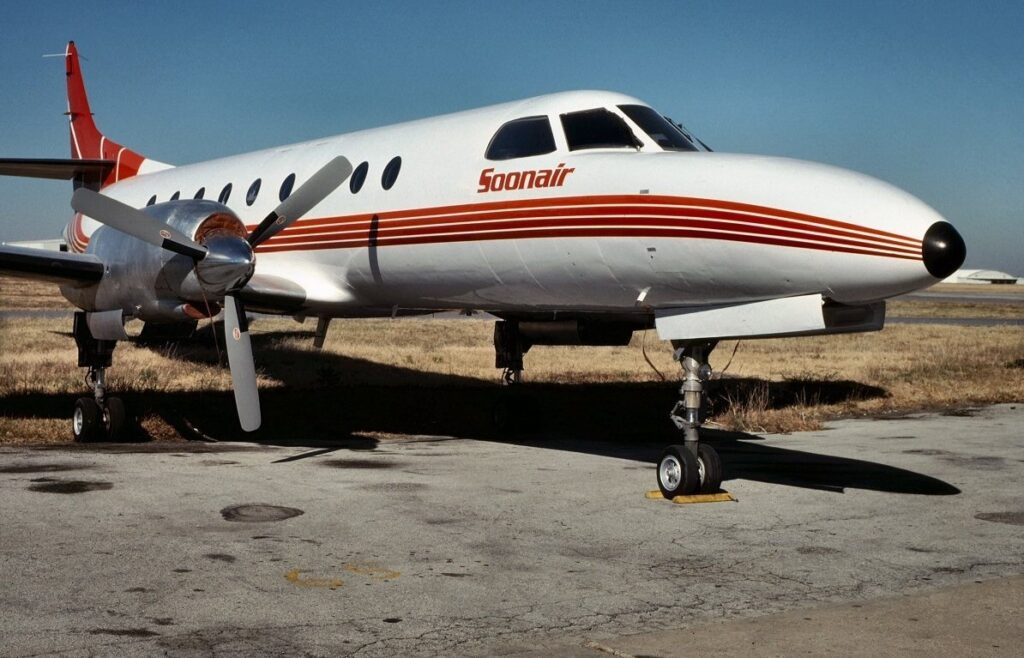
Photo by Ellis M. Chernoff.
On more than one occasion at an intermediate stop, the local operator could not get their ground power unit to start, so I had to keep an engine running while the cargo was off or on loaded. This had to be anticipated as they would not fuel the plane with the engine running.
Other cold-weather experiences included not being able to get the propeller blades on the start locks during shutdown. They must have frozen in the release condition during flight. So when the engine shut down, the blades went to feather. It is not possible to start this type of engine with the propeller in feather. The normal remedy is to use a device (we carried one) to manually twist the blades back to the proper flat angle, and the locks should engage. We tried it and they didn’t move. After conferring with the boss by telephone, I came up with a novel idea: I would use the manual unfeathering pump to return the prop to the start angle, and while there, would initiate the start. This had to be done before the oil tank was depleted. It took all four hands in the cockpit, but I pulled it off.
On another occasion, I made an intermediate stop in Olathe, Kansas, in a blizzard. During the crosswind landing, the snow was blowing across the runway from right to left, creating a strange visual apparition. But the landing and taxi to the ramp were uneventful. However, while I was inside on the telephone to get weather updates, my first officer came in telling me that the engines had seized. In just the few minutes since the engines were shut down, snow had blown into the inlet, melted, and then froze inside. It looked like an old freezer that had not been defrosted in months! The flight cancelled and we were stuck there until the next afternoon. Lesson learned: always cover the engine inlets.
A few months had gone by, and Soonair, on advice of a consulting firm, reconfigured one of the remaining Metros back to passenger configuration and was setting up to launch scheduled passenger service between Tulsa and Dallas Love Field. One day, I was called into the office of the Director of Operations. I had guessed they would want me to operate the passenger flights since I already had plenty of that type of service. But no, I was instead informed that due to recent first officer upgrades, I could either be laid off or accept rehire as a first officer. What a shock, especially since I had raised this issue during my initial interview and was assured that this would not occur. So now, with no notice, my choice was half pay or no pay.
A couple of days later, I would head out in the right seat with a newly minted captain who had previously been my co-pilot. Adding insult to injury, I was expected to supervise him and give him training and operational experience. As a professional, I would do this, but I informed my new captain that he would get to fly all of the legs, not only to find out what it’s like to be in charge, but to experience the fatigue and conditions he could expect flying with less experienced co-pilots. On a minimums approach into St Louis in the middle of the night, he nearly landed on the grass when he looked up from the instruments, tensed up, and ruddered the plane away from the runway. I grabbed the controls and got things back in order.
Another one of these new captains made a poor choice when faced with in-flight icing and strong headwinds. He thought he could descend out of the icing and get less headwind rather than climbing out of the clouds. The result of this error had us at 3000 feet using full power and barely maintaining flying speed. The de-icing systems could not cope with the very heavy ice we were accumulating. Were it not for flying out of the clouds into clear air, we would have ended up a wreck out in some field.
One day, one of the pilots now flying the Volpar into Portland, Maine, encountered the same FAA inspector who tried to intimidate me. However, this time the inspector succeeded, and the captain called the Director of Operations to say that he could not operate the next scheduled departure on threat of losing his pilot certificate. The D.O. told him it was nonsense; his job is to fly. Faced with two ultimatums, this pilot resigned, and all of the other pilots at Soonair, including me, supported him through mass resignation.
It was time to pack up and move again.
